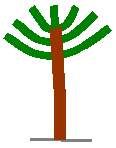Hallelu-JaH].gif)
The great golden Menorah
- Sign of God’s Presence
André H. Roosma
14 February 2012
(NL: 21 Jan. 2012)

In a previous edition we saw that the palm tree was a sign that
pointed to the presence and the speaking of God.
And in the previous edition that God had spoken to Moses from a fire on the
top of a palm tree.
We also saw, that the great golden Menorah
that first stood in the tabernacle and later in the temple in Jerusalem,
was in fact an image of this (for a description, see
Exodus 25:31-40).
The seven great oil lamps on top the Menorah
and its six branches represented the fire and the light of God Himself.
Therefore that fire had to be kept burning at all times.2
Because the great golden Menorah was so holy
– so connected with God Himself – it had to be made out of one
piece of pure gold, and only holy olive oil was to be used for the lamps.
It is interesting as well to look at the basis of the word מנורה - Menorah.
In the old script1 it reads:      .
The heart of this is: נור -
nur - .
The heart of this is: נור -
nur -    - literally: what comes forth from attachment to God: that you are going
to shine as well, radiating/spreading light (attachment) around you, like God Himself is light and
propagates it. (Think of how Moses’ face was
literally shining whenever he had been in the presence of God
- Exodus 34: 29-35; cf. Mattit-Yahu/Matthew 17: 2).
This is the old form of the Hebrew word ניר - nir - lamp. The Menorah
had many ( - literally: what comes forth from attachment to God: that you are going
to shine as well, radiating/spreading light (attachment) around you, like God Himself is light and
propagates it. (Think of how Moses’ face was
literally shining whenever he had been in the presence of God
- Exodus 34: 29-35; cf. Mattit-Yahu/Matthew 17: 2).
This is the old form of the Hebrew word ניר - nir - lamp. The Menorah
had many ( water, abundance, many) of those lamps and was meant to contribute
‘to joyful adoration’ ( water, abundance, many) of those lamps and was meant to contribute
‘to joyful adoration’ ( worship, adoration, wonder, joy). worship, adoration, wonder, joy).
So the great golden Menorah was a fullness
of lamps/light (coming forth from being attached to God
Himself), directed at joyful wonder and worship towards Him.
I do not understand how some people who study the First Testament
can say that it is only about ‘the law’, or that it is tough.
In the rich symbolism I find so much joy, so much beauty, so much
inspiration...
Here, too, I see richly illustrated how we are called to search for the
presence of God YaHUaH, and, from our belonging to Him, to spread His
light in this world around us (cf. Mattit-Yahu/Matthew
4: 16; 5: 14-16; Luke 2: 32; 8: 16; 11: 33-36; Ephesians 5: 8; Philippians
2: 15; 1 Peter 2: 9; 1 John 1: 5-7; 2: 8-10).
Hallelu YaH !
Notes
| 1 |
The word explanations given here are based in part on
an extensive study of the oldest pictographic Bible script. See: André
H. Roosma, ‘The Written
Language of Abraham, Moses and David – A study of the pictographic
roots and basic notions in the underlying fabric of the earliest Biblical
script’  , Hallelu-YaH Draft
Research Report, 1st English version: 18 April
2011 (1st Dutch original:
January 2011). , Hallelu-YaH Draft
Research Report, 1st English version: 18 April
2011 (1st Dutch original:
January 2011). |
| 2 |
About those lamps, which had to be kept burning 24/7
some interesting stories can be told.
At the re-dedication of the second temple (at the time it had been polluted
by oppressors) there was at some moment only enough holy olive oil for one
day, but the Menorah burned a week long on that. This is the basis of the
Jewish festival of Chanukkah. It became a festival in particular, because this
wonder was experienced as a sign of the return of YaHUaH to this new
temple.
Almost the opposite happened during the first decades after Jesus’
death, resurrection and ascension. Then often the Menorah could not be kept
burning continuously; often it its light was extinguished without any cause...
A similarly clear sign that God’s presence had left the temple.
Christians are called, to care for sufficient oil in their lamps,
sufficient fullness of God’s Spirit in them, to be able to emit light
at all times (Mattit-Yahu/Matthew 25). |
Also the branches of the Menorah are worth investigating.
The Bible calls such a branch a קנה
- qaneh (/qanah; think of cane - stick) - stem
(a hollow, long stalk); in the old script:    - to
rise, come forth from, to worship/ celebrate/ live. To me, this confirms the
idea that the Menorah is based on the palm tree. - to
rise, come forth from, to worship/ celebrate/ live. To me, this confirms the
idea that the Menorah is based on the palm tree.
(By the way: the same word qaneh is used also for the
shoulder joint. This appears remarkable when we continue:)
Those branches – three on each side – are the fronds of the
palm tree, emerging/rising from its top, and giving the palm a look like
a figure with raised, moving arms; so: joyfully worshipping. At that worship,
that praise to Him, YaHUaH likes to dwell! (Psalm 22: 3)
Great work André, a
very important link in the building up of the Body of Christ.
God bless
AndréThanks,
Simon, for your encouraging feedback!
God bless you too!
|



Hallelu-JaH].gif)
